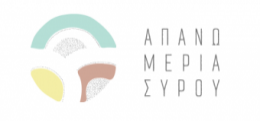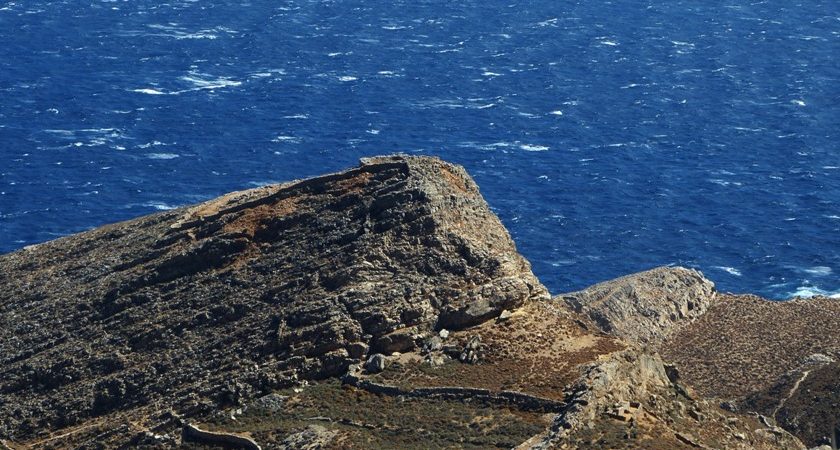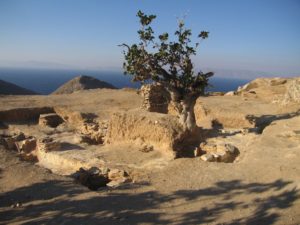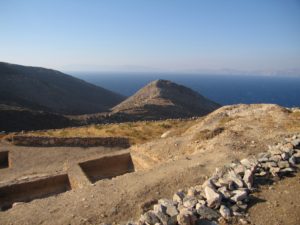Sites and their Dating
By Marisa Marthari
Chalandriani and Kastri are located on the northeastern coast of the mountainous North Syros or Apano Meria. They look towards Tinos and Andros. Chalandra is the name of a small fertile plateau extending to the sea through two rocky slopes. At its highest point in the south there is a small church of Panagia [Virgin Mary] of Chalandriani. To the west of the Chalandra Plateau is the steep hill Kastri whose top rock is marble. The two are separated by the deep ravine of Potamia, which ends at Cleisoura Bay. At some places there, there is springing water throughout the year. The excavations that took place in the area during the past and present centuries brought to light the fortified settlement of Kastri, located at the top of the hill that goes by the same name, and the extensive cemetery of Chalandriani, where the rows of its graves once stretched across the plateau of Chalandra, in the northeast of the modern settlement of Chalandriani, and reached to the sea.
The fortified settlement dates back to the Kastri phase (about 2,300-2,200 BC). The cemetery includes mainly tombs of the Early Cycladic period (Keros-Syros phase, approximately 2,700-2,400 / 2,300 BC) and only a few that are contemporary to the Kastri settlement. Also, in the area, there is a second prehistoric settlement, the settlement of Chalandriani, that spreads around the church of Virgin Mary of Chalandriani and has been identified since the last century but has not been systematically investigated. It has been assumed that the Early Cycladic period tombs belonged to the settlement of Chalandriani, which would have been already inhabited since that period.
In any case, these two settlements of Kastri and Chalandriani must have occupied an important place in the settlement model of Syros corresponding to the Early Bronze Age. They were at a key point in the communication network that connected Mainland Greece with the Asia Minor coast: the Asia Minor coastal zone was then closer to the core of the civilized world than the central and western Aegean. This should have been one of the reasons for their particular development.
The exact settlement model of Syros in the Early Bronze Age is not yet fully known. Further systematic investigations are required, although in the last few years superficial investigations and pilot excavations by the 11thEphorate of Prehistoric and Classical Antiquities at certain locations (Galissas, Delfini) have shown that Syros had a fairly complex grid of settlements, as is the case in other Cycladic islands. A first idea of the dispersion of sites in the Early Bronze Age is depicted in the map produced by Aron, which is based on earlier research but also on his many years of sightseeing in Syros.
HISTORY OF THE INVESTIGATIONS
Until now, the [archaeological] research in the area of Kastri-Chalandriani has gone through three phases.
The first phase is placed in the second half of the previous century. The explorations started from the cemetery. G. Papadopoulos was the first to excavate there in 1861 (Papadopoulos 1862, 1865) followed a decade later, in 1872-73, by the Syriot anthropologist Kl. Stefanos. In 1896, R.C. Bosanquet, a passerby from Syros, also investigated a tomb (Bosanquet 1895-96). Systematic excavations were carried out at the Chalandriani cemetery in 1898 by Chr. Tsountas, who investigated 540 tombs. The same year, Tsountas also excavated the walled settlement of Kastri, which he called the acropolis of Chalandriani. The excavations brought to light the front wall and the northern wall as well as a small part of the settlement, mainly the buildings that are adjacent to the wall. Tsountas presented the results of his excavations in the Cyclades in his two major articles in the Archaeological Journal of 1898 and 1899 (Tsountas 1898, 1899). In the second of these, he refers extensively to the results of his research in Syros.
More than 70 years later, in the 1960s, and in particular in 1962, there was a second phase of research activity in the region. Caskey visits Chalandriani and Kastri and makes interesting observations (Caskey 1964). E.M. Bosserr continues the excavation at the Kastri settlement. The new excavation confirms the existence of a western wall and reveals a larger part of the settlement to the top of the hill (Bosserr 1967). The then Chief Curator of Antiquities of Cyclades Chr. Doumas excavates 8 tombs in the western part of the Chalandriani cemetery (Doumas 1977, 128-130) and the then Ephorate of Cyclades N. Zafeiropoulos with the assistant of E. Kakavogianni, two other tombs. In the 1990s, a third phase of research began in Chalandriani. Hekman conducts a superficial survey in the area of the cemetery in 1989 and discovers the remains of some tombs that were previously excavated (Hekman 1991, 1996). Since 1990, the 11thEphorate of Antiquities has strengthened the area’s protection regime (see below, p. 32) encouraging the resurgence of the research. In the area of the modern settlement of Chalandriani, the exploration of the subsoil begins with trial sections, where there is an interest to build and monitor the dry-stone walls which are demolished in order to collect the prehistoric material that is embedded in them. The results of the surveys so far confirm the view that under the modern settlement there is an early Cycladic settlement. The maintenance of the material of Kastri and Chalandriani begun since 1993—and continues—and it is kept in the Museum of Syros and is valuable for the research.
THE CEMETERY OF CHALANDRIANI
This cemetery is the most extensive early Cycladic cemetery that has been investigated so far. More than 600 tombs have been excavated (Papadopoulos 1862, 1865; Tsountas 1899, 78-116; Doumas 1977 in general and especially 128-130). The cemetery includes two sections, West and East (see also Renfrew 1972, 373-375, 528-531; Hekman 1991, 1996). The graves are arranged in clusters in each section. Sections and clusters probably reflect different social groups. Also, the variety in the number and type of grave goods (funerary offerings)suggest differences in the social status of the dead. Generally, the structures of the community or communities served by the vast necropolis at least during the Early Cycladic period seems to be quite complex. The tombs are dug underground and have a polygonal, circular or mixed plan. Their walls are built with overlaid stones without bonding mortar, in the freestanding way. The aperture in the center of the pseudo-dome is covered with a sizeable top plate. The entrance often has a threshold and pilasters of upright slabs and is blocked with a slab or dry-stone wall. In some, there is a simple path way in front of the entrance. This type of tombs is only found in Syros.
There are some known facts related to the burial customs. They placed the dead in the fetal position in the tomb without covering with soil. A stone plate was often placed beneath the head like a headrest. The grave goods were placed either on the floor of the tomb, usually in front of the deceased’s face, or in a niche on the wall.
Grave goods varied. The ceramic art is very interesting. The completely undecorated ceramic jugs and conical cups dominate in number. However, there are also two impressive categories of vases that are represented in the goods, the inscribed and the polished ones. Special mention is to be made of the clay pan-shaped vessels of the settlement with the elaborate printed and engraved decoration that belong to the polished category. Most of these vessels depicting rowing boats were found in the Chalandriani cemetery, which leads the researchers to consider the cemetery settlement one of the most important of the Early Bronze Age in the Cyclades (Brookbank 1989).
There are enough marble vases especially bottles, simple or tall ones. On the contrary, marble figurines are rare, mainly anthropomorphic in shape, of the variety of dokathismata. Rectangular panels and grinders of various types, as well as obsidian blades, belong to the typical grave goods.
Metal objects abound: needles, hole punchers, tweezers, scrapers. Fishing hooks are rare. There were also several silver, bronze and bone pins with elaborate heads; they were a part of the deceased’s clothing for the attachment of the garments.
An interesting type of finding is the bone paint-storing vases, many of which store cyan color paint. Red lumps were found in three tombs. It has been assumed that these colors were used to color the face and body. Jewelry was rare, as were the clay spindles.
Finally, food remains (goat bones, sea shells) were found in some bottles and cups.
THE SETTLEMENT OF CHALANDRIANI
The [ancient] settlement of Chalandriani lies under the modern settlement by the same name. The first to locate it was Tsountas, who even carried out a trial excavation and found remnants of walls. Tsountas believed this to be a very important settlement. Other important researchers of the Cycladic prehistory after Tsountas considered it to be the main settlement of the area (Tsountas 1899,78, 106-107, 127-130; Caskey 1964, 64; Renfrew 1972, 176). So far only Hekman has offered a contrary view (1991, 20, 31, note 2, 1996, 52, 72).
The investigations carried out there by the 11thEphorate of Antiquities in recent years confirm and reinforce the view that the settlement of Chalandriani lies under the modern settlement that goes by the same name. The Early Cycladic settlement seems to have been a large one for the Cyclades of the 3rd millennium, with an area of probably more than 10 ha. It is a settlement of the size of Scarcos of Ios and of Agia Irini of Kea, if not larger. Walls were recovered and moveable findings were gathered. However, further research is needed to establish the settlement time frame with certainty.
THE SETTLEMENT OF KASTRI
The settlement of Kastri (Tsountas 1899, 116-130 Bosserr 1967) is surrounded by a wall to the north, west and probably to the east but not to the south, where it is naturally fortified. Its total area is estimated at 5 ha. The wall consists of the front wall and the main innerwall with horseshoe-shaped towers. Both are built of large carved marble blocks without connecting clay except from some portions of the towers. The marble must have been quarried on the site.
The front wall extends only along the northern slope, which is the most accessible from the sea. It consists of two long arched sections. The east part is slightly farther south of the west part so that about a 0.60-meter wide gate is created between them. The main wall consists of a north long section, a shorter west section and perhaps an east section in proportion to the west one, as Bossen assumes, although no traces of it were found. The northern wall is reinforced with five horseshoe-shaped towers. The remains of only one tower are preserved in the western wall.
The entrance to the settlement was possible from both the north and the west. Those who wanted to enter from the north had to first cross the gate of the front wall and then enter the settlement through the central gate of the tower B or the gate to the west of the tower C. For those coming from the west, the entrance was through the gate to the south of tower Z.
The configuration of the settlement is centralized. Most buildings are spreading to the top organized in building islets. The islets are separated from each other by narrow and often stepped streets that are generally parallel and perpendicular to the wall. The buildings of the islets are not separated by double walls except for a few exceptions, while this is the rule in other larger Cycladic settlements, such as Scarcos of Ios. The few independent buildings, all of which are elongated, are attached to the northern wall along their long axis. An exception is the peculiar small space 20 situated alone in the middle of the road.
The buildings themselves consist of one or two rooms of rectangular or trapezoidal shape and usually rounded corners. The two rooms usually form an angle between them and are rarely aligned along the same axis. The way of building is like that of the fortification, but the main building material is small and thin marble slabs.
The buildings either had their own, or shared with others, courtyards enclosed with a built-in fence wall. Built-in fireplaces were found in spaces 4, 11 and 22. The fireplaces in Kastri consist of two vertically positioned slabs which in some cases have between them another horizontal one that served as the base of the fireplace.
The movable finds show that the settlement of Kastri was full of life. The fragments of large pithos (clay barrels)found inside buildings echo organization for the storage of goods. The ceramic, stone-carving, miniature and metalwork arts seem to have been well developed.
The fine ceramics include jugs with bilk-like mouths for pouring out water, goblets with two handles, bell-shaped cups, conical cups with leaf or matte prints on their base, goat sacks and spherical compasses. The coarse clay items contain many types of pithos with tufted relief decoration, amphorae, basin-shaped hearths cradled in the ground as well as circular portable hearths. In addition to ceramics, clay objects were found among which several spindles.
About stone vessels, utensils and tools, there were several marble bottles, rectangular panels, ellipsoid grinders and various types of scrapers. Core parts, blade pieces, and obsidian processing waste were also found.
There are powerful finds related to metalwork practicing in the settlement. Several metal objects were found in Kastri. Such is the impressive find of a silver diadem with a stunning embossed decoration that depicts human forms and animal figures. Of interest are also some bronze objects, such as double axes and a spear tip. More important, however, is the finding of clay funnels for the melting of metals that retain inside them copper or lead rust, as well as schistolith (double-sided) and clay molds for the manufacture of tools and weapons.
It has even been assumed that building 11 was a metal workshop. Around the fireplace, slags mixed with coal and burnt fragments of vases were uncovered. An assembly of bronze objects (chisels, hole punchers, pins, and saw parts) was found in a corner on the floor in front of the fireplace. At the same spot, there were found miniature cone-shaped punchers and obsidian blades on one of which there was pasted metal residue. Along with the tools, one of the four clay funnels of the settlement was found here.
Finally, information on the inhabitants’ dietary habits is gathered from the organic residues. There were plenty of goat bones and sea shells.
The relations Kastri seems to have had with Asia Minor in terms of material culture have been particularly discussed. Certain types of ceramics found in Kastri, such as the two-handle goblet and the bell-shaped cup, find their parallel on the eastern side of the Aegean (Rutter 1979). It has been proved by laboratory analysis that the copper of several objects from Kastri, the Northeast Aegean islands and Asia Minor sites is similar in composition (Davis 1987, 727, 754). Recently, in the Liman Tepe (Klazomenes), a massive 60-ha settlement of the Kastri type was found (Erkanal 1997). More generally, Kastri’s period is a period of intensification in the relations between the Cyclades and other regions, such as Evia, the islands and the coasts of the eastern Aegean.
Source: Syros, Chalandriani-Kastri. From the research and the protection to the recovery of the archaeological site. Marisa Marthari.
Ed. Ministry of Aegean, 11thEphorate of Antiquities–Cultural Ministry
Translated by Constantine Hatziadoniu



